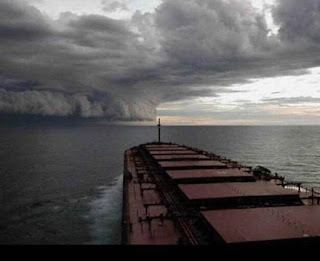Hurricane Harvey's Catastrophic Destruction
Hurricane Harvey roared to shore on August 25 as a Category 4 storm, with 130-mph winds by the time it hit Rockport, Texas. Heavy rainfall has caused catastrophic flooding in Houston and along the Texas Gulf Coast, displacing thousands and causing dozens of deaths.
More than 2.3 million people live in rain-soaked Houston, and hundreds of thousands have been without power. (Learn the science behind what makes Harvey so deadly.)
Harvey is the strongest storm to hit a U.S. coast since Hurricane Wilma in 2005, and it has destroyed many buildings along the coast. Harvey was downgraded to a Category 1 hurricane by early Saturday morning before being designated a tropical storm, but the most catastrophic effects of the storm are unfolding over several days. Flooding is among the worst in U.S. history.
As much as two feet of water has fallen in some neighborhoods, and dams have spilled over their capacity, adding to the floods. A disaster declaration requested by Texas Govenor Greg Abbott was granted. The proclamation allows federal funds to be used for local disaster relief.
Tracking Harvey's Destructive Path Through Texas and Louisiana
The hurricane made landfall in southern Texas Friday night as a Category 4. As the storm spun offshore and then back again, it continued to dump massive amounts of rain on Texas and Louisiana, raising the risk of additional flooding.
While it is possible for storms to regain strength over water, the National Weather Service did not expect Harvey to intensify as it moved through the Gulf of Mexico and back inland, due to cooler water churned to the ocean’s surface. Maximum sustained winds remained near 45 miles per hour as of Tuesday afternoon.
Thousands Are in
Shelters Across the State
Shelters have opened across the state, big and small and as far away as Dallas, where some evacuees ended up after fleeing the storm. The state Department of Public Safety counted 16,000 people in about 120 shelters on Tuesday.
In Carrizo Springs, the Dimmit County Rodeo Arena served about 200 people, but most had left to try to return home on Tuesday.
The largest by far was the convention center in Houston, and Mayor Sylvester Turner said more large shelters would be needed.
Floodwaters continue to rise in inland rivers as Harvey dumps rain.
Thousands of people likely remain stranded, and an estimated 30,000 to 40,000 homes have been destroyed in the Houston area as Hurricane Harvey, now a deadly tropical storm, continues to batter the Gulf Coast with torrential rains, flooding and strong winds.
Harvey made its third landfall, just west of Cameron, Louisiana, today at 4 a.m. Central Time, with maximum sustained winds of 45 mph, according to the National Weather Service. As of 10 a.m., the slow-moving storm had picked up some speed, moving northeast at 8 mph, and its center was about 30 miles from Lake Charles, Louisiana.
Before that, it battered the Beaumont-Port Arthur area in southeastern Texas, dumping more than 2 feet of rain in some parts.
The brunt of the storm's impact has begun to shift to western Louisiana and, now, for Harris County, "the biggest challenge is going to get people back in their homes," Emmett said. "We've got to get those people back into their normal lives as soon as possible."
An undetermined number of people are missing. The Coast Guard is leading a search for two volunteer rescuers missing after their boat crashed and capsized on Cypress Creek near the North Freeway early today. Authorities found a third rescuer clinging to a tree, according to the Harris County Sheriff's Office.
The Harris County Sheriff's Office urged people awaiting rescue to "hang a towel or sheet prominently" for rescuers to see because addresses are difficult to spot.
Harvey is expected to weaken and continue moving to the north and east across the Lower Mississippi Valley and Tennessee Valley through Thursday. But the National Weather Service said Harvey still has the potential to cause "life-threatening flooding."
"Catastrophic and life-threatening flooding continues in southeastern Texas and portions of southwestern Louisiana," the service said in an advisory this morning. "Excessive runoff from heavy rainfall will cause flooding of small creeks and streams, urban areas, highways, streets and underpasses, as well as other drainage areas and low-lying spots."
Officials were forced to evacuate the shelter at the Bob Bower Civic Center in Port Arthur this morning after it began to fill with water. One witness, who was forced to relocate, said
The worst is not over for Texas, Abbott warned today. He said 24,000 National Guard troops, including all of Texas' force, have been deployed in the state and will be crucial in the weeks and months to come to help restore order.
The National Guard has made 8,500 rescues, evacuated 26,000 people and done 1,400 shelter-in-place welfare checks in Texas so far. Meanwhile, there are 32,000 people in shelters throughout the state, Abbott said.
Five days after Harvey first made landfall, FEMA said it's still in "life-saving, life-sustaining" mode, with recovering survivors being the top priority. FEMA Administrator Brock Long said at a news conference today that there are more than 12,000 emergency staffers on the ground in Texas and Louisiana, spread across 50 counties. The agency is operating more than 230 shelters in Texas, housing more than 30,000 people.
some areas of the center had almost 4 feet of water inside.
Rescuers continue to pull people from rising floodwaters. The traumatized and weary evacuees often have nothing but the soaked clothes on their backs. Aid groups are working valiantly to provide shelter, emergency services and hope.
There are several ways you can help.
Help People Affected by Hurricane Harvey. Donate Now:
https://www.redcross.org/donate/hurricane-harvey?scode=RSG00000E017&utm_campaign=Harvey&gclid=CjwKCAjwxJnNBRAMEiwA8X_-QaOetb-WQZ_e0SHrLlGRZMiPdNs8OsAZgJ6v9TLwIkoVIIIPfauZvhoC3-MQAvD_BwE&gclsrc=aw.ds&dclid=CKuN38T0_9UCFQQ4TwodqPoEiw
Here's how you can help the victims of Hurricane Harvey:
http://www.cnn.com/2017/08/25/health/iyw-harvey-how-to-help/index.html
Here's how you can help the victims of Hurricane Harvey:
http://www.cnn.com/2017/08/25/health/iyw-harvey-how-to-help/index.html
Blog done by: Egypt A. Assanti of Eta Sigma Delta SL Sorority
"Pray for the victims of Hurricane Harvey"














No comments:
Post a Comment